
It’s November of 1940 and the folks gathered at The Shy Gazelle are precisely those you’d expect to run into in a London pub just a month after the Battle Of Britain. Gregarious manager Fred Shattock and his affable wife Nora are offering pub regulars their customary warm welcome as they serve the usual libations to entertainer Lyia Viven and her lover George Bourne, magazine editor Chorley Bannister, chums Janet Braid and Alma Broughton, and middle-aged couple Mr. and Mrs. Grainger. Conversation revolves around the usual topics—news of the Grangers’ soldier son, “still there, on the Isle Of Wright;” the “dreadfully negative” nine o’clock BBC Nightly News broadcast; George’s defense of Lyia’s vocal talents against Chorley’s nasty digs, etc.
Nevertheless, there are hints that not all is as we might expect it to be. Comments made about the the ways Chorley appears to have “readjusted” the opinions expressed in his magazine seem odd. Then there’s the brief arrival of a German-accented customer whose presence silences the enthusiastic buzz of conversation, hardly what we’d expect following what Battle Of Britain expert Stephen Bungay tells us was the Nazis’ first major defeat and one of the crucial turning points of the Second World War.
At nine o’clock on the dot, Fred, Nora, and their customers pause to listen to the evening’s BBC news headlines, touting the reopening of Parliament and a military parade set to move from Hyde Park to Trafalgar Square to Westminster to Buckingham Palace. “In the first open landau,” the crisply British-accented announcer reads, “will be seated the Führer. The carriages following will contain Air Chief Marshal Goering, Dr. Goebbels and high-ranking Army, Navy, and Air Force officers…”
It is with this chilling list of names that the lights go down on the first scene of Noël Coward’s rarely performed 1947 war drama Peace In Our Time, now getting its first U.S. production in over sixty years in a world premiere adaptation by Barry Creyton for L.A.’s classical theater ensemble The Antaeus Company. Simply put, this is a production no Coward lover (or lover of superbly staged drama) will want to miss.
Over the course of two acts spanning the years between November 1940 and May 1945, Peace In Our Time answers a question many may have asked themselves in the decades since the end of World War II (i.e., what might have happened had Germany won the Battle Of Britain) and does so in the most gripping, suspenseful, and entertaining of ways.
Coward gives us a cast of characters whose reactions to German occupation run from brazen consorting with the enemy to stoic acceptance of the ubiquitous Nazi presence to out-and-out rebellion, as his play turns from its first act slice of London life to the suspense thriller it becomes in its second act.
Adapter Crayton eliminates a number of Peace In Our Time’s peripheral characters (though the cast of twenty-three remains a large one indeed), trims some of the play’s wordier scenes, and—most significantly—adds a dozen or so Noël Coward songs, accompanied on piano by Shy Gazelle regular Archie and performed by Lyia, Fred, Archie, the Graingers, and various others who likely found music the best medicine in a world gone mad.
The result of this revision is as fine a production of a new/old play as you’re likely to see any time soon, directed with consummate finesse by Casey Stangl, performed by two very different but equally gifted sets of actors, and designed by some of the most accomplished talents this or any theater town has to offer.
As in previous productions, The Antaeus Company has brought together Company Members, A2 Ensemble Members/Academy Students, and Guest Artists and divided them into two casts, dubbed here the Epps Cocoas and the Stubbs Specials, with members of one cast or the other filling in for performers whose film/TV or other work might necessitate a night or matinee off. The dueling casts are, by very definition, decidedly distinct, and given the quality of talent involved, equally worth seeing. Many theatergoers will elect to see both casts as I did, and find it as impossible to play favorites.
As a reviewer who prides himself on commenting in considerable detail on individual performances, it pains me greatly not to be able to do so about those on stage at North Hollywood’s Deaf West Theatre—but at nearly four dozen actors, there is simply too much stunning work being done to even know where to start, let alone when to finish raving about the performances of Josh Clark and Steve Hofvendahl (Fred Shattock); Eve Gordon and Lily Knight (Nora Shattock); Danielle K. Jones and Abby Wilde (Doris Shattock); Jason Dechert and Brian Tichnell (Stevie Shattock); Bill Brochtrup and JD Cullum (Chorley Bannister); Karianne Flaathen and Zoe Perry (Lilly Blake); Drew Doyle and Buck Zachary (Alfie Blake); Emily Chase and Rebekah Tripp (Janet Braid); Anna Mathias and Amelia White (Mrs. Grainger); John Combs and Philip Proctor (Mr. Grainger); Graham Hamilton and John Francis O’Brien (Billy Grainger); Raleigh Holmes and Rebecca Mozo (Lyia Vivian); Daniel Bess and Christopher Guilmet (George Bourne); Jason Henning and Rob Nagle (Albrecht Richter); Mark Doerr and Peter Larney (Dr. Venning); Kendra Chell and Ann Noble (Alma Boughton); Joseph Fuhr and Patrick Wenk-Wolff (Kurt Foster); Etta Devine and Rosalyn Mitchell (Phyllis Mere); Belen Greene and Joanna Strapp (Gladys Mott); Jesse Sharp and Paul Culos (Bobby Paxton); Melinda Peterson and Susan Boyd Joyce (Mrs. Massiter); John Allee and Richard Levinson (Archie); and Chris Clowers as a soldier. (See the Antaeus website for detailed cast/performance schedules.)
A number of roles do give their interpreters particularly shining moments. There are the salt of the earth Shattocks, whose “we won’t be licked” attitude is one we’d like to believe the Brits would have maintained even during occupation; the self-serving Chorley, who represents everything the Shattocks hold reprehensible; the valiant young Stevie and Doris and Billy, one of whom proves heroic to the death; the plucky Janet, whose anti-collaborator speech and pair of slaps earn audience gasps and cheers; and the bickering Blakes, the dastardly Albrecht, and the cluelessly amoral Gladys. Allee and musical director Levinson provide impeccable piano accompaniment to the sultry vocal stylings of Holmes and Mozo—and the entire cast.
Special mention must be made of how authentically British this American ensemble sounds, so much so that you might want to stick around after the show for proof that they’re not actually subjects of the Queen. (Kudos to dialect coaches Tuffet Schmelzle and Tracy Winters.)
As for the production’s design team, there aren’t enough superlatives to describe Tom Buderwitz’s minutely detailed scenic design (with myriad properties by Heather Ho), Jessica Olson’s pitch-perfect period costumes, John Zalewski’s impeccable sound design, and Jeremy Pivnick’s rich, vivid lighting design. Steve Rankin has choreographed some authentic-looking tussles and John Apicella deserves applause for his scene-setting projections. Lara E. Nall is stage manager.
Additional credit must be paid to AnnaLea Arnold (assistant director); Tony Amendola, Nagle, and John Sloane (co-artistic directors), Kathleen Eads (managing director), Irlando Ferreira (production assistant), Dana Friedman (assistant director), Harry Groener (music consultant), Adam Meyer (production manager), Whitney Oppenheimer (costume design assistant), Mila Sterling (graphic designer), R. Scott Thompson (technical director), and Tamara Williams (assistant stage manager).
None of the above would be possible but for L.A.’s 99-seat plan, which makes a mostly Equity ensemble of this size and caliber financially feasible. It’s a sure bet that you won’t be seeing a professional production of Peace In Our Time anywhere other than Los Angeles, the city where theater is (to paraphrase A Chorus Line lyricist Edward Kleban) “What We Do For Love.”
There may never be another chance to see Peace In Our Time in our time. Don’t miss it!
The Antaeus Company, Deaf West Theatre, 5112 Lankershim Blvd., North Hollywood.
www.Antaeus.org
–Steven Stanley
October 20 and 23, 2011
Photos: Geoffrey Wade (Epps Cocoa cast on left; Stubbs Special cast on right)

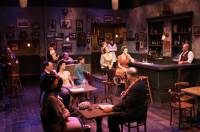
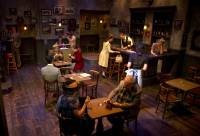
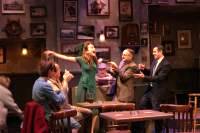
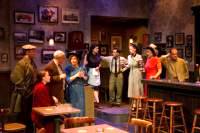
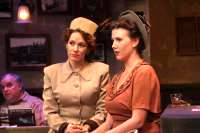
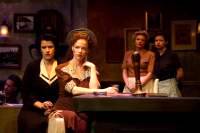
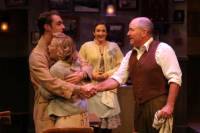
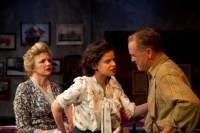
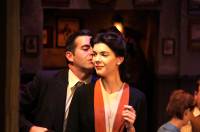
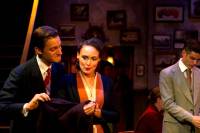
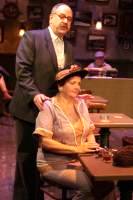
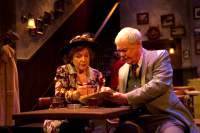

 Since 2007, Steven Stanley's StageSceneLA.com has spotlighted the best in Southern California theater via reviews, interviews, and its annual StageSceneLA Scenies.
Since 2007, Steven Stanley's StageSceneLA.com has spotlighted the best in Southern California theater via reviews, interviews, and its annual StageSceneLA Scenies.







 COPYRIGHT 2024 STEVEN STANLEY :: DESIGN BY
COPYRIGHT 2024 STEVEN STANLEY :: DESIGN BY